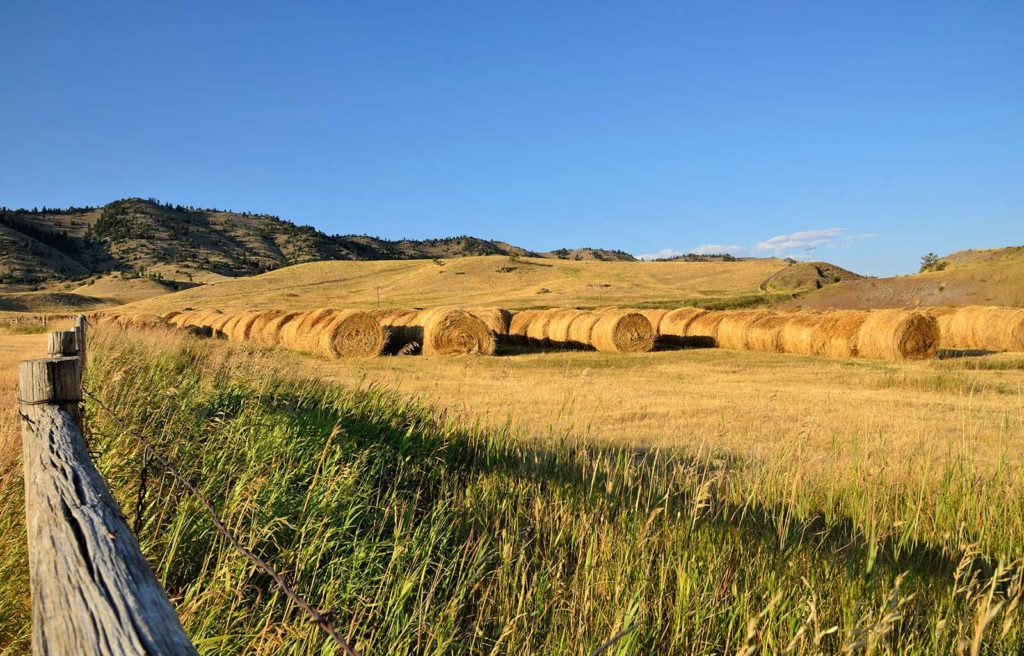Those hills aren’t black. They’re gold.
Before I jump ahead to an important decision that had its genesis in 1872, I’ll share a bit of my experience traversing Montana. I doubt that people who assert that Montana is a particularly beautiful state have spent any significant amount of time driving through the eastern plains. At no point in my drives from Great Falls to Billings, from Billings to Little Bighorn National Monument or on to Devils Tower did I encounter a scenic view that prompted me to stop my car and take a photo. This isn’t to say that it’s impossible to perceive this landscape as beautiful but for me, it’s certainly not one that would inspire traveling a great distance to see.
While I didn’t take any photos, I have downloaded a few from around the internet that I think are representative so you can decide for yourselves.
Here’s an aerial view of Hardin, Montana from landsat:.
This one is from a real estate site for Toluca:.
Or this one from a bus company’s website:.
Now I’ll return to the lesson at hand.
In March 1872 the Secretary of the Interior, Columbus Delano, wrote a letter that hinted that the United States had no intention of honoring the terms of the 1868 Fort Laramie Treaty:.
I am inclined to think that the occupation of this region of the country is not necessary to the happiness and prosperity of the Indians, and as it is supposed to be rich in minerals and lumber it is deemed important to have it freed as early as possible from Indian occupancy. I shall, therefore, not oppose any policy which looks first to a careful examination of the subject… If such an examination leads to the conclusion that country is not necessary or useful to Indians, I should then deem it advisable…to extinguish the claim of the Indians and open the territory to the occupation of the whites.
It’s likely that the sentiments expressed in this letter were part of the policy that took shape over the ensuing several years.
(As I read about the history that might impact my travel experiences, I’m often shunted in unexpected directions because I learn that some disparate events are connected in ways I’d never known or imagined. Other times, I find odd {and sometimes not so odd} coincidences linking one trip to another. For example, having Jim Bridger appear in the narrative about my trip to Utah followed by his role in the current narrative is coincidental but not particularly odd.
On the other hand, finding a connection between my 2017 trip to Wyoming and Montana and my 2016 trip to the Balkans and Budapest was certainly surprising. That link is the financial Panic of 1873. I’d read about it in preparing for my visit to Budapest but didn’t include it in my journal because it wasn’t essential to understanding the history of that particular narrative.
While economists don’t agree on the causes of the 1873 financial crisis, most agree {and most historians concur} that its genesis was in Vienna the capital of the Austro-Hungarian Empire. That panic spread fairly quickly and engulfed the United States in the worst financial crisis the nation had faced in its first century as a country. As we’ll see below, had economic conditions been better in 1873, some of the events of 1874 might have been delayed thereby clearing a different historical path.)
I’ll skip ahead now to 8 June 1874 the date General Alfred H Terry, the chief of the Department of the Dakota in Saint Paul, Minnesota, ordered the formal exploration of the Black Hills. He gave command of the expedition to an officer he held in high regard, Lieutenant Colonel George Armstrong Custer. Custer’s mission leading the 7th Cavalry was to explore the region and evaluate possible sites for a fort in or near the Black Hills.
Departing from Fort Abraham Lincoln, Dakota Territory on 2 July 1874, the expedition was a mile long train that included more than 1,000 troops, 300 head of cattle to provide meat, and a scientific corps comprised of a geologist and his assistant, a naturalist, a botanist, a medical officer, a topographical engineer, a zoologist, and a civilian engineer. Two miners, Horatio N Ross and William T McKay, were also attached to the scientific corps. Traveling on a southwest route, they reached the Belle Fourche River on 18 July.
Custer sent Charley Reynolds, a courier who traveled at night to avoid being spotted by the Native Americans, ahead to Fort Laramie where he filed Custer’s reports of the beautiful trees, sheer cliffs, clear streams, grasses, flowers, and the early summer climate of the area. Perhaps of equal importance he reported few signs of Indian habitation. These reports then flowed back to General Terry who filed a 3,500-word dispatch that was picked up by the press. It included the following:
“… gold has been found at several places, and it is the belief of those who are giving their attention to this subject that it will be found in paying quantities. I have on my table forty or fifty small particles of pure gold…most of it obtained today from one panful of earth.”
The reaction was swift and predictable. By the time Custer returned to Fort Lincoln on 30 August, the Black Hills gold rush was on. Cheyenne, Virginia City, Sioux City, Sidney, Helena, and Bismarck, all saw their populations swell with groups of financially desperate, gold-hungry men preparing for prospecting trips into the forbidden Black Hills.
In 1875, the administration of President Ulysses S Grant tried to buy the Black Hills region from the Sioux who promptly refused to sell their sacred land under the rights of the 1868 Treaty. In the middle of the winter, the administration then ordered them to report to reservations by the end of January 1876. Many, including those led by Crazy Horse and Sitting Bull, refused to do so. Others were unable to do so because of the winter weather conditions.
Although even the Indians who refused to comply with the government orders were acting within the rights granted by the Treaty, Grant labeled anyone who hadn’t reported to the reservation as “hostiles” and the army, under General Terry, developed plans for a three-pronged campaign that was to begin in the late spring of 1876 with the intent of bringing them in.
Under the plan, one force under Colonel John Gibbon would march east from Fort Ellis (near Bozeman, Montana today). Simultaneously troops under General George Crook would march north from Fort Fetterman in southeastern Wyoming and Terry’s column, with the 7th Cavalry under Custer’s leadership, would march from Fort Lincoln on a route already quite familiar to Custer.
As we’ll see, circumstances will intervene to disrupt this strategy and shift the balance of power at the Battle of Little Bighorn. But before I begin my discussion of the battle itself, it’s important to take a deeper look at George Armstrong Custer the American soldier whose defeat etched his name into legend.


